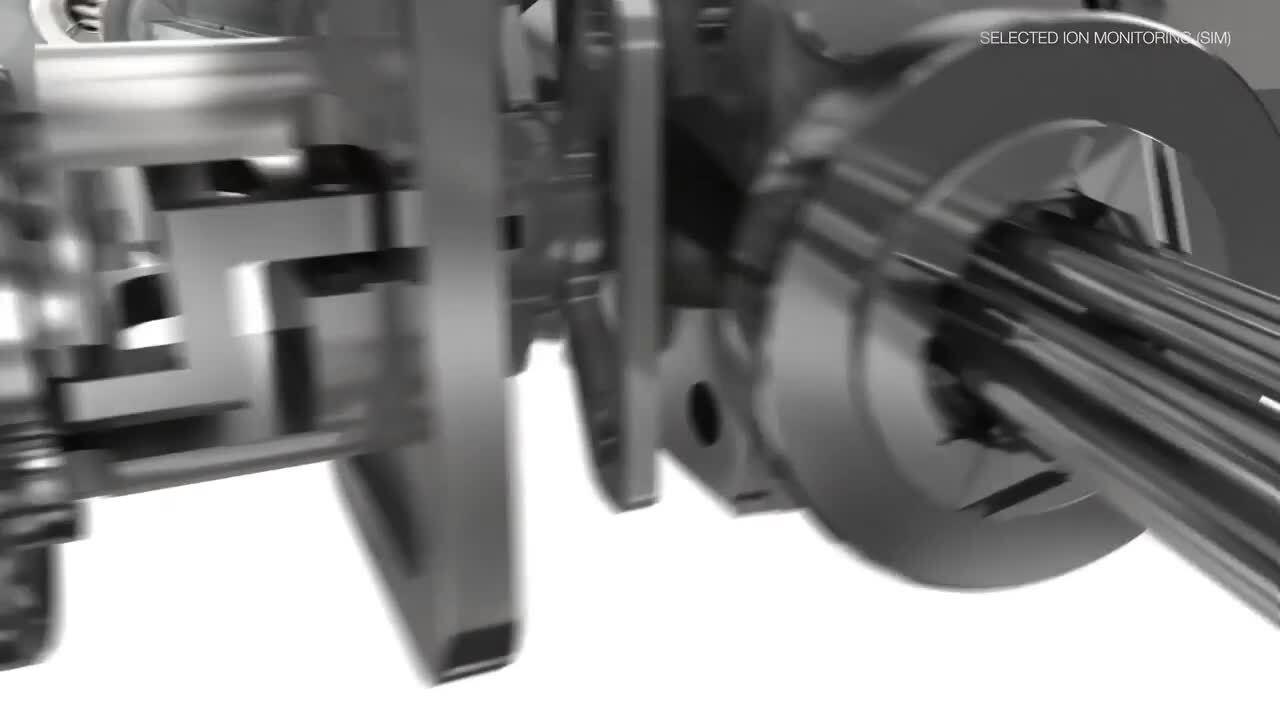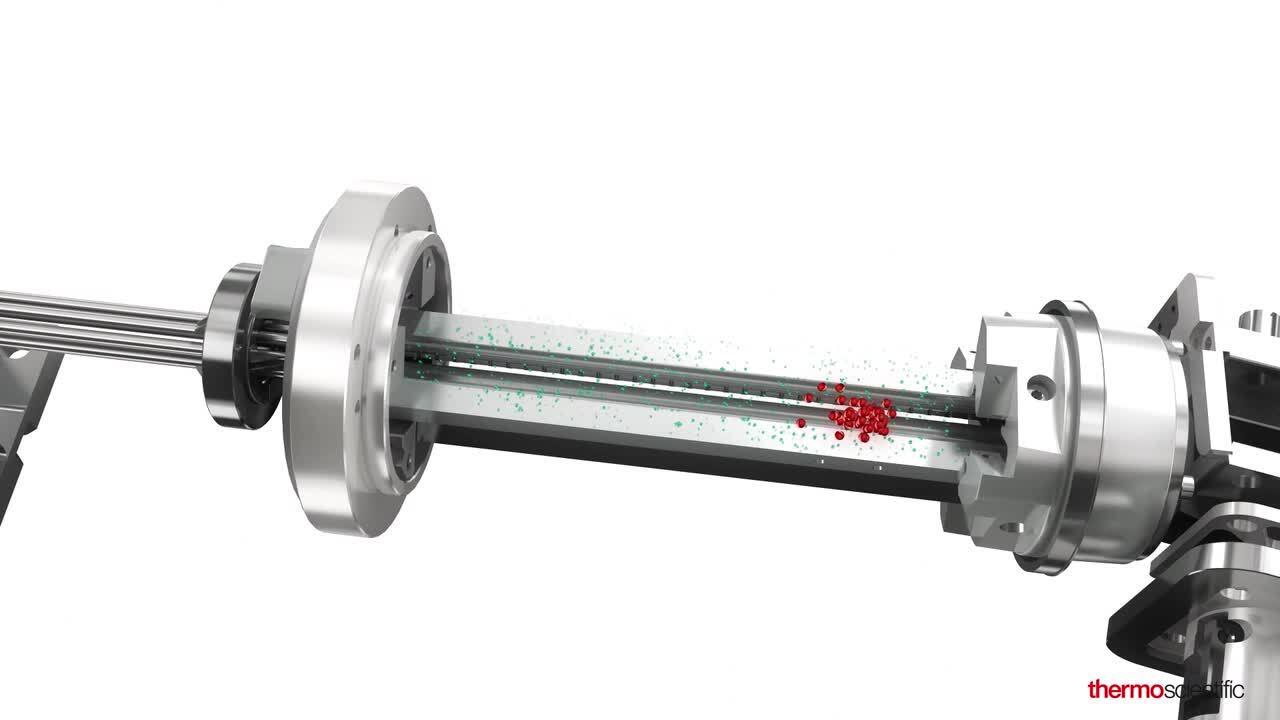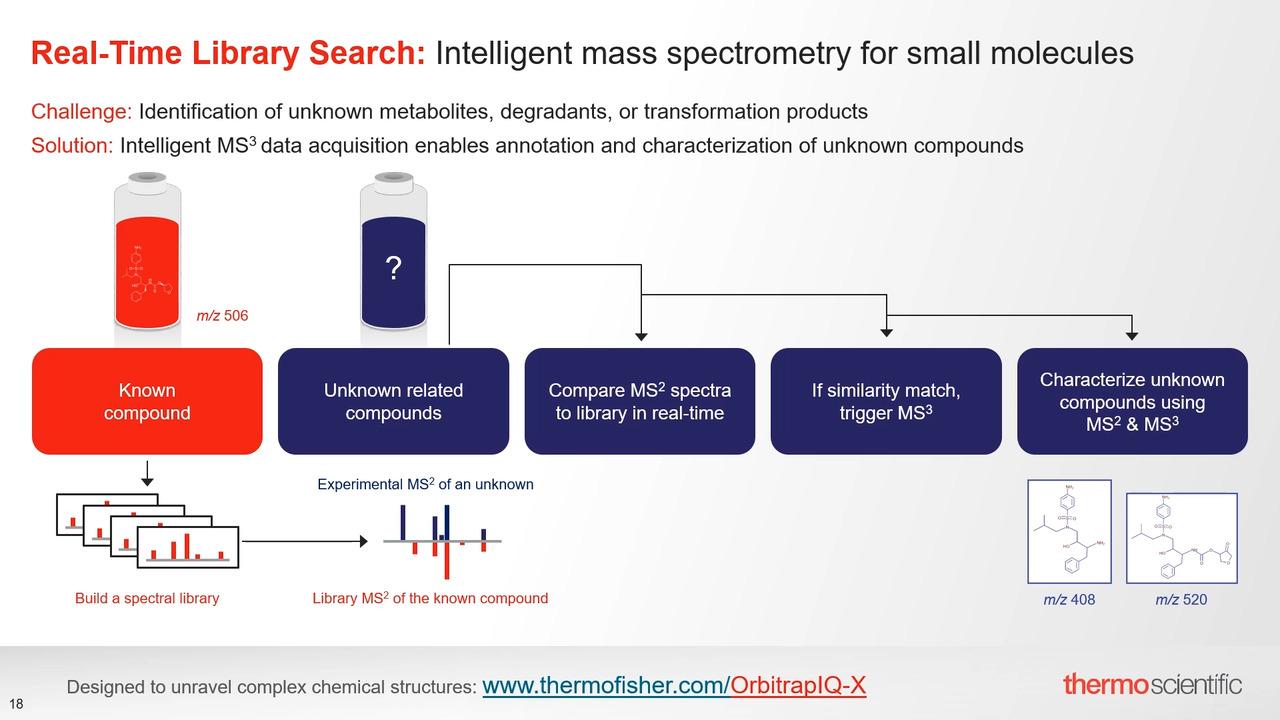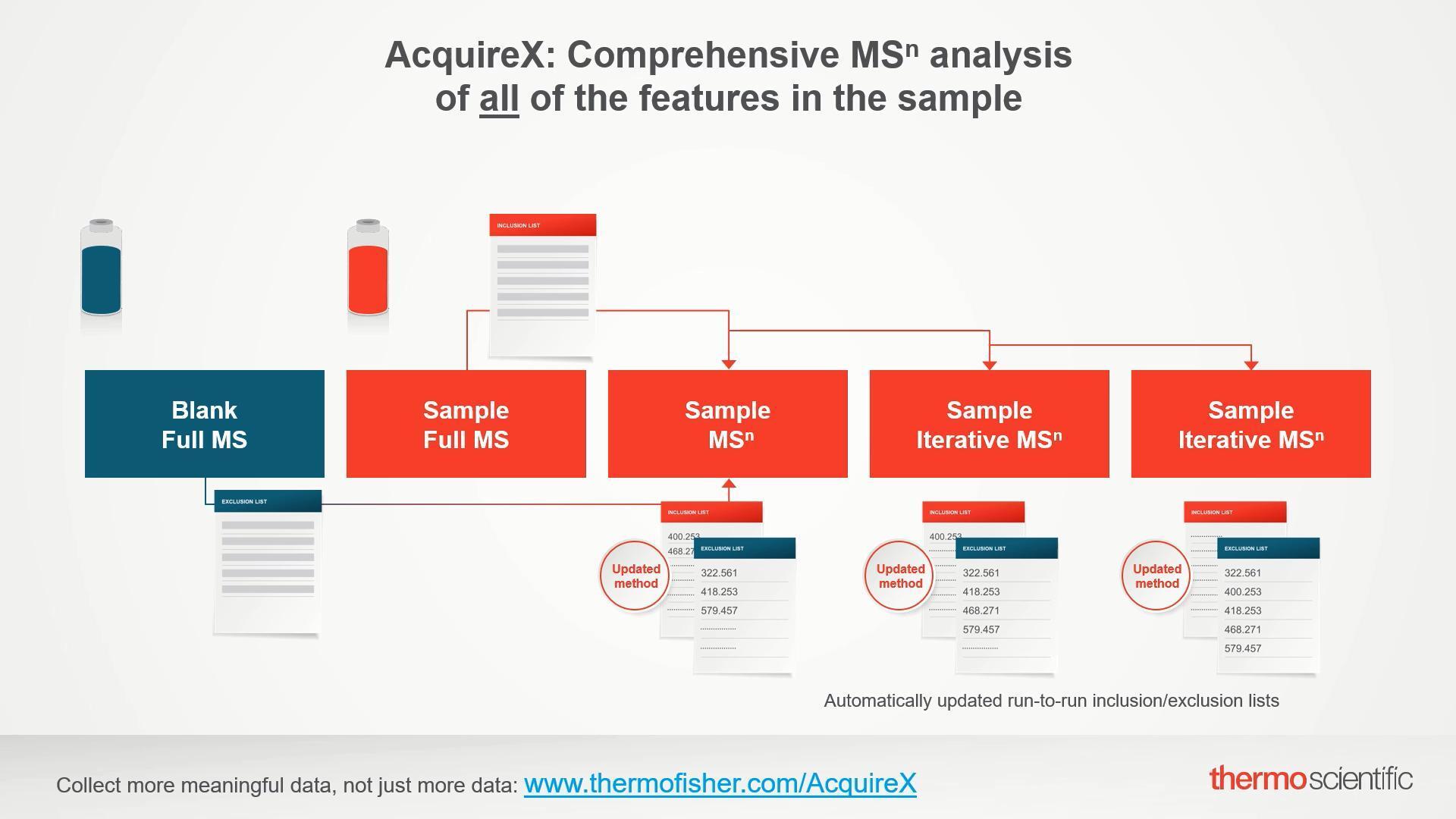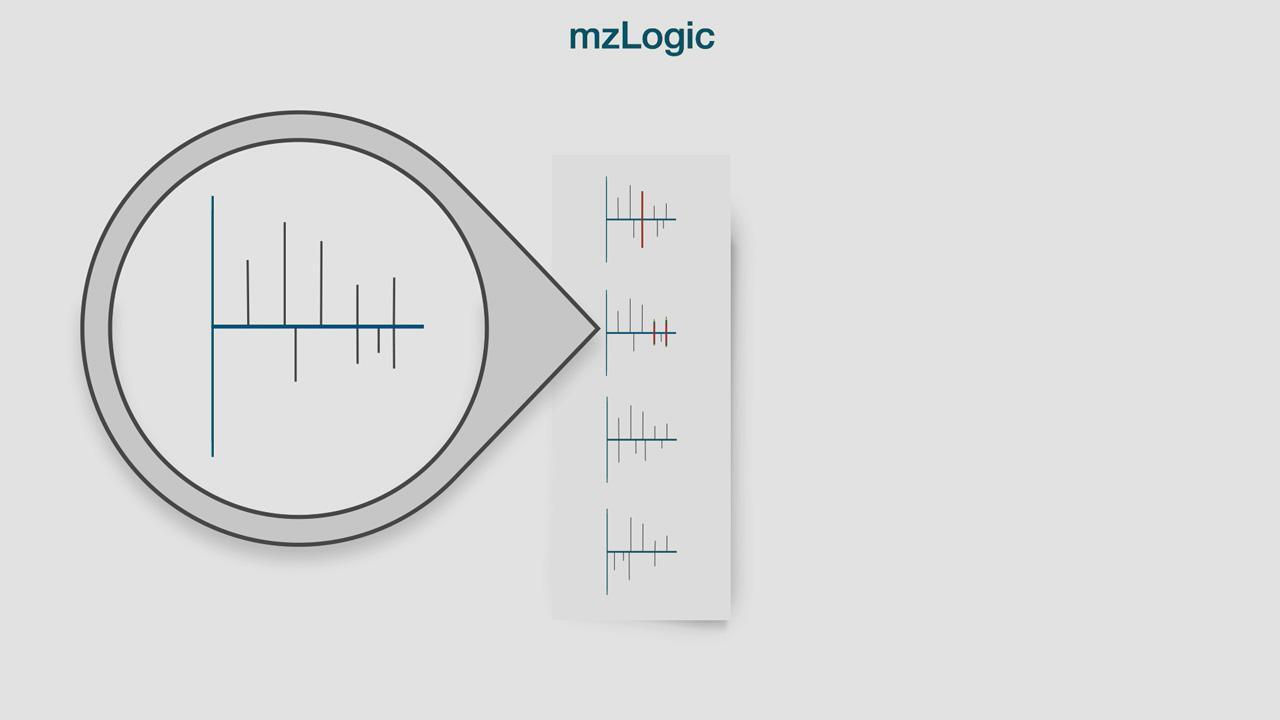Search Thermo Fisher Scientific

Designed for small-molecule analysis
The Thermo Scientific Orbitrap IQ-X Tribrid mass spectrometer is designed to reveal complex chemical structures for compound identification and structure elucidation of small molecules. The system combines industry-leading mass analyzer technology with intelligent automation with real-time decision making, intuitive software, and remote, hands-free calibration, to address the complexities of small-molecule identification and characterization so you can confidently collect more meaningful data.
From acquisition to analysis, the system lets you detect and characterize more low-abundance analytes in complex matrices for structure elucidation and unknown compound annotation. This is enabled by intelligent data acquisition using Real-Time spectral library searching and Thermo Scientific AcquireX workflows to reveal more compounds with certainty.
Highlights of Orbitrap IQ-X Tribrid mass spectrometer
Automation, easy-to-use software to simplify setup and data acquisition
Instrument control software with pre-built templates and ready-to-use experimental parameters are designed to help you quickly profile your complex samples. Automated instrument calibration using dedicated Auto-Ready ion source hardware ensures the instrument is ready to go when you are set.
Intelligent acquisition to collect more meaningful data
The intelligent Real-Time Library Search and AcquireX data acquisition tool automates MSⁿ data acquisition and increases profiling efficiency to help you obtain a higher number of compounds with distinguishable fragmentations to empower deeper analysis.
Data analysis tools to empower speed, flexibility and deeper analysis
A comprehensive, integrated set of data acquisition and analysis tools enables you to confidently and quickly produce information-rich MSⁿ data from complex samples.
LC-MS companion software tools for structural elucidation illuminate MSⁿ data
LC-MS software tools including MSⁿ mass spectral trees, novel spectral prediction techniques, in-silico fragmentation modeling, and precursor ion fingerprinting assist you to identify knowns and elucidate structures of unknown unknowns.
Hardware and data acquisition technology
Instrument hardware design and an efficient, comprehensive data acquisition workflow makes the Orbitrap IQ-X Tribrid mass spectrometer the preferred solution for performing small-molecule identification, characterization, and quantitation.
Instrument hardware design and intelligent data acquisition
Proven Tribrid architecture combines a quadrupole, linear ion trap, and Thermo Scientific Orbitrap HRAM technologies to acquire the rich MSⁿ data from every sample. Multiple fragmentation techniques: — Collision-induced dissociation (CID), Higher-energy collisional dissociation (HCD), and optional Ultraviolet photodissociation (UVPD)— are available at any stage of MSⁿ, with subsequent mass analysis in either the ion trap or ultra-high resolution Orbitrap mass analyzer.
The Orbitrap IQ-X Tribrid MS ion path schematic
Throughout the Orbitrap IQ-X Tribrid MS, best-in-class technologies deliver solid results. The Auto-Ready ion source standardizes calibration with dedicated hardware to support consistent performance over time. The Thermo Scientific EASY-IC ion source uses a second ion source to generate specific calibrant ions to provide real-time adjustment of the instrument’s mass accuracy to less than 1 ppm, enabling corrections for scan-to-scan variations and superior mass accuracy. The advanced quadrupole technology includes a segmented quadrupole mass filter which enables higher transmission at narrower isolation width down to 0.4 m/z, improving sensitivity and selectivity. The ultra-high field Orbitrap analyzer can achieve resolutions up to 500,000 at m/z 200 distinguishing between ions of interest and interfering ions with optional resolving power up to 1,000,000 (1M) resolution for fine isotope structure. The dual-pressure linear ion trap provides MSⁿ rates of up to 45Hz and sensitive mass analysis of three complementary fragmentation types: CID, HCD and optional UVPD.
Real-Time Library Search enables on-the-fly spectral matching for higher confident identification
Real-Time Library Search technology provides on-the-fly spectral searching against a local and customizable mzVault library to allow for decision-based triggering of MSⁿ scans. Using this intelligent technique increases confidence in metabolite identification and characterization and improves structural analysis of isomeric species.
The Met-IQ data acquisition specifically uses Real-Time Library Search technology to enable selective detection and characterization of unknown compounds that are structurally related to known compounds, such as drug metabolites to pro-drugs.
AcquireX data acquisition technology for more meaningful data
The AcquireX workflow captures more low-abundance analytes with an integrated suite of software analysis tools to improve small-molecule structural elucidation identification. Using the AcquireX data acquisition tool significantly streamlines the workflow, reducing bottlenecks and making both identification and characterization faster and more feasible.
AcquireX data acquisition supports five workflows to maximize flexibility for your experiments. Data acquisition options enable rapid profiling across multiple samples and exhaustive sample interrogation through replicate injections. Each method improves the quality and the number of compounds sampled with distinguishable fragmentation spectra for sample and study characterization.
AcquireX Intelligent Data Acquisition Workflow
Download this Smart Note to learn the ways in which AcquireX data acquisition can help you address the challenges of small-molecule study and characterize your samples with fragment-rich spectral data while improving lab efficiency.
Enabling software and tools for mass spectrometry data analysis
Combining Real-Time Library Search with AcquireX data acquisition workflows and other enabling tools delivers a dramatic reduction in the number of compounds without MSⁿ spectra and a significant increase in the number of compounds identified. Using Thermo Scientific Compound Discoverer software in combination with a range of spectral libraries (Thermo Scientific mzCloud mass spectral fragmentation library), compound databases, and ranking tools (Thermo Scientific mzLogic algorithm) significantly aids identification and characterization of unknowns. The use of spectral library fragmentation information and structural databases provides higher confidence in assignments for more compounds in less time.
Compound Discoverer software extracts insights from information-rich small-molecule HRAM data
Compound Discoverer mass spectrometry data analysis software streamlines unknown identification, determination of real differences between samples, and elucidation of biological pathways. It serves as a hub to seamlessly connect users to the tools they need to analyze productively and confidently.
Delivering confidence for small-molecule identification
Learn more about how we address the challenges in small-molecule identification with mass spectral libraries. The mzCloud spectral libraries and Thermo Scientific mzVault software are designed to address the challenges of small-molecule identification for routine and research applications.
Mass spectral libraries and ranking tools
The mzCloud compound databases and mzLogic algorithm ranking tools aid unknown putative identification to help you find answers quickly and drive decision making. The tools are readily available online and comprise an extensive mass spectral fragmentation library as well as structural databases.
Mass Frontier spectral interpretation software
Thermo Scientific Mass Frontier software supports MSⁿ spectral ion tree searching and enables custom library creation. The software utilizes high quality, fully curated experimental spectral and fragmentation libraries to provide greater insights, understanding, and confidence when turning your data into actionable knowledge.
Compound annotation using MSⁿ data
Compound annotation using high-quality MSⁿ data provided by the Orbitrap IQ-X Tribrid mass spectrometer combines precursor ion fingerprinting with substructure analysis of unknown metabolites to address common bottlenecks in compound identification. Additional tools available for LC-MS-based structure elucidation include MSⁿ mass spectral trees and in-silico fragmentation.
The above image shows comparative MS/MS spectra for two flavonoid structural isomers where the only structural difference is associated with aglycone substructure. The addition of the two sugar rings to the base aglycone substructure result in similar MS/MS spectral patterns that prohibit correct structural identification despite low mass errors for precursor and MS/MS product ions. Incorporation of neutral-loss triggered MS³ performs tandem mass spectral analysis and subsequent MS³ acquisition that result in a clear definition of the two isomeric compounds.
Connect Cloud Platform
Connect your laboratory to drive more insights from your data
Thermo Fisher Connect Platform is part of our full suite of digital capabilities for secure, cloud-based data storage, scientific analysis apps and peer collaboration tools. In addition, our asset management tools allow you to remotely schedule time on your lab’s instruments and monitor your run via your mobile device.
Using Thermo Fisher Connect, it’s easy to connect, save and synchronize your files to your secure, personal account, which includes 1 TB of free storage. Peer and document collaboration tools enable secure group collaboration.
Small-molecule characterization and identification clouding your decision making?
Learn more about how cloud-based technologies, including mass spectrometry analysis software, are becoming more prevalent in laboratories.
Specifications
| Specifications | Attribute | Description |
|---|---|---|
| Hardware specifications |
Thermo Scientific OptaMax NG ion source | Features sprayer with improved alignment and stability, interchangeable HESI/APCI probe, and an exhaust port design that efficiently removes solvent vapor, to reduce chemical noise and improve uptime. |
| Auto-Ready ion source | Integrates source with dedicated emitter and ion transfer tube to simplify calibration and maintenance. Controls and reports results directly in the instrument control software interface. Internal Thermo Scientific Pierce FlexMix Calibration solution consumable lasts ≥3 months with regular use. |
|
| Electrodynamic Ion Funnel | Captures ions as they leave while automatic tuning results in broad transmission curves, to reduce ion losses, and increase sensitivity. | |
| Advanced Active Ion Beam Guide | Reduces noise with an axial field and low pass filtering, that prevent neutrals and high-velocity clusters from entering the quadrupole mass filter. | |
| Quadrupole mass filter | Features MSⁿ precursor ion selection with high efficiency transmission from m/z 50 to 2,000 and highly specific precursor isolation window widths down to 0.4 amu. | |
| Ion-routing multipole | Provides efficient ion trapping and ion transfer to the Orbitrap and linear ion trap mass analyzers while performing Higher-energy Collisional Dissociation (HCD) at any MSⁿ stage. | |
| Orbitrap mass analyzer | Achieves resolving power of up to 500,000 FWHM at m/z 200 and isotopic fidelity up to 240,000 FWHM. Supports optional resolving power of 1,000,000 (1M) at m/z 200. | |
| Dual-pressure linear ion trap | Improves quantification with dual-dynode detector for high linear dynamic range, MSⁿ precursor isolation from m/z 50–2,000 and sensitive mass analysis of three fragmentation types including CID, HCD and optional UVPD. | |
| Vacuum system | Uses stainless steel high-vacuum analyzer chambers. Enhances transmission of the ions into the Orbitrap mass analyzer by reducing pressure in the ultra-high vacuum region to <2 x 10-10. Uses split-flow turbomolecular pump controls vacuum in three regions. |
|
| Optional hardware | Ultraviolet Photodissociation (UVPD) ion source | Includes a Class 1, 213 nm laser system with 2.5 kHz repetition rate, delivering >1.2 μJ per pulse. |
| 1M resolution | Enables mass measurements at ultra-high resolution of 1,000,000 FWHM at m/z 200. | |
| Thermo Scientific FAIMS Pro Duo interface | Performs online gas-phase separation based on differential ion mobility for orthogonal separation and selectivity. Optimizes performance for 100 nL/min to 1 mL/min flow rates. | |
| Performance | Mass range | Full MS Mass Range: 50–2000 m/z; MSⁿ Mass Range (detection only): 40–2000 m/z. |
| Orbitrap mass analyzer resolution | 7,500–500,000 (FWHM) at m/z 200. Using 1M Option supports up to 1,000,000 (FWHM) at m/z 200. |
|
| Acquisition rate (under defined conditions) | Orbitrap mass analyzer MSⁿ up to 40 Hz. Ion trap MSⁿ up to 45 Hz. |
|
| Mass accuracy (under defined conditions) | <3 ppm RMS using external calibration. <1 ppm RMS using internal calibration with EASY-IC source. |
|
| MS/MS electrospray ionization (ESI) ion trap sensitivity | Using a HESI III probe, sensitivity is measured using 2 μL of a 50 fg/μL solution of reserpine (100 femtograms total) injected at a flow of 500 μL/min to produce a minimum signal-to-noise ratio of 100:1 for the transition of the isolated protonated molecular ions at m/z 609 to the largest two product ions, m/z 397 and m/z 448, when the mass spectrometer is operated at unit resolution in the full scan MSⁿ mode, m/z 165–615. | |
| Dynamic range | >5,000 within a single MS acquisition. | |
| Multiplexing using ion-routing multipole | Up to 10 precursors per acquisition using the quadrupole mass filter for targeted MS² and Selected Ion Monitoring (SIM). | |
| Polarity switching | One full cycle in 1.1 sec (one full scan in positive mode and one full scan in negative mode at a resolution setting of 30,000). | |
| Installation requirements | Power | 230 VAC ± 10% single phase, 15 Amp, 50/60 Hz, with earth ground for the instrument. 120 or 230 VAC single phase with earth ground for the data system. |
| Gas | Ultra-high purity helium (99.999%) with less than 1 ppm each of water, oxygen, and total hydrocarbons. High purity nitrogen (99.5% pure, flow rate 15 L/min) gas supply for the API source and the ion routing multipole (IRM). | |
| Dimensions (WxDxH) | 1270 × 767 × 703mm (50 × 30.2 × 27.7 in) | |
| Weight | 318 kg (700 lb) without data system, vacuum rough pumps and optional items. | |
| Environment | System averages 2,800 W (10,000 Btu/hr) output when considering air conditioning needs. Operating environment must be 16–26 °C (59–78 °F) and relative humidity must be 50–80% with no condensation. Optimum operating temperature is 18–21 °C (65–70 °F). |
Resources
Technical notes
White papers
LC-MS Instrument Support Center
LC-MS Software Support Center
Mobile Lab Apps



